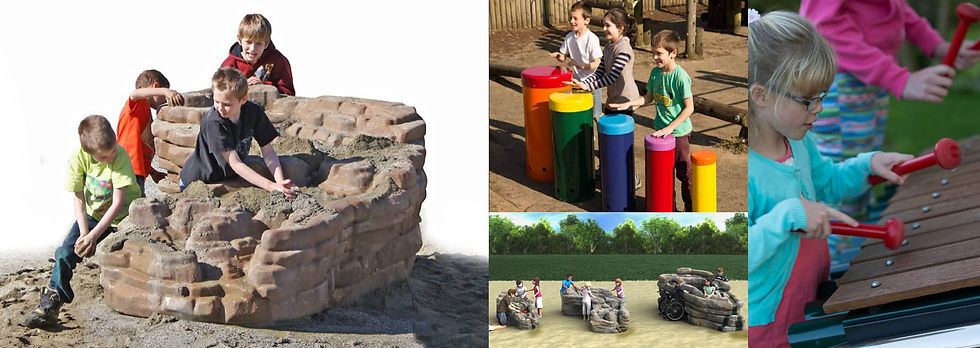Inclusive Play for Deaf-Blind Awareness
- Shana Friesen
- Jun 27, 2018
- 4 min read
Updated: Sep 10, 2021

Playgrounds should be fun for all children but having a good time can be more difficult for those with special needs. Most playgrounds do not cater to those with visual or auditory impairments, and the ones that do often have only limited or secluded activities that can ostracize children. We want to highlight some techniques and best practices for designing an accessible play environment for children who are deaf, blind, or visually impaired.
Auditory Disabilities
Studies between 1988-1994 found that nearly 15% of children 6-19 have some form of low- or high-frequency hearing loss. Although this loss and its effects on daily life vary from person to person, there are several methods for making play equipment more accessible to all hearing abilities.
Visual, Tactile and Sensory Elements

Those with auditory disabilities benefit from visual, tactile, and sensory play elements. However, it is important that these activities not become overstimulating. Bright colors and symbols can help to engage children with auditory disabilities while large signs with pictures can assist in their understanding and navigation of the play equipment. When organizing an accessible play environment, creating a mix of different elements in the same areas is also important for encouraging both those who have auditory disabilities and those who do not to work together, promoting communal play and socialization.
A common misconception is that those with auditory disabilities can not enjoy activities with sounds, but those with partial deafness or hearing impairments can still participate in these features, especially if they also have visual and tactile aspects. For example, children with hearing impairments may enjoy being able to make their own music with a musical sidewalk or xylophone. Including elements that captivate overlooked senses can also be a great addition, such as a fragrant garden. Get creative!
Cochlear Implant Dangers
Slides are a fun activity for all children; however, they can cause issues for those with cochlear implants as the plastic can create static. Although this static is not harmful, it can create an uncomfortable shock for those with cochlear implants. In comes cases, this static can even cause the implants to become temporarily ineffective or create issues that require an audiologist to reboot the device. While researchers are attempting to develop plastic equipment that doesn’t interfere with implants, nothing has yet come to market. In the meantime, metal slides, which do not create static, are best for children with cochlear implants.

Visual Disabilities
Despite common misconceptions, blindness is not an all-or-nothing disability. Only 15% of visually impaired people are totally blind and 85% of people have some remaining sight. Visual impairments can be divided into two main categories which each require different levels of accommodation: low vision and blindness. Low vision is not correctable and interferes with daily activities while legal blindness is a visual acuity of 20/200 or less in the better eye even with correction such as glasses or contact lenses. Total blindness is beyond this level of sight, at which point there is no light perception or form perception at all.
Textured Surfacing and Safety

Rubberized or textured surfaces and mats on a playground can help children with visual impairments differentiate areas so they can better orient themselves and navigate environments. Rubberized surfaces also provide additional safety as children can feel the boundary of the play area beneath their feet and understand where it ends so as not to wander into dangerous areas such as sidewalks, roads, or parking lots. Fencing can also be used as a safety precaution to protect children from wandering away, not only for the visually impaired but for others, such as those with autism spectrum disorder who tend to wander. Other considerations such as braille or large print signs in easy-to-spot locations can also help older children to find their way around independently.
For children with low vision, bright-colored markers in yellow, blue, or red on muted backgrounds can be used to denote steps, the edge of slides, platforms, or other tripping hazards. Inclusive play equipment like adaptive swings with harnesses also make playgrounds more accommodating and empower children to play on their own or with other kids without having to rely on a caregiver for help.
Auditory and Tactile Elements

Many playground features are visual in nature. Adding musical play equipment can be a great way of encouraging those with vision impairments to get involved and have some fun. Play equipment that makes sound can also help those with visual impairments to have an auditory landmark for where things are and help them to navigate the playground.
That being said, those with visual impairments are not limited to only auditory play. Textured and large equipment can be especially stimulating for children with visual impairments and can help aid in their development. For example, sand and water attractions can be great ways of engaging those with disabilities to play as it stimulates a variety of senses while also being a fun activity to do independently or in a group.
Accessible Playgrounds in Action: Adam’s Adventure

Looking for an example of a playground that makes good use of play equipment that engages those with auditory and visual impairments? Check out Adam’s Adventure, an inclusive playground inspired by Adam Mlodzinski. At seven years old, Adam contracted a disease that left him blind and with cognitive impairments and a seizure disorder. Adam’s Adventure was funded by the community and specifically designed to accommodate those like Adam. The playground provides a space for those with mobility impairments, auditory disabilities, autism spectrum disorder, cognitive impairments, visual disabilities, and more to play freely. Whether children wish to swing, climb, play music, hang out with friends, or do other activities, they can do so at Adam’s Adventure.

Kommentarer